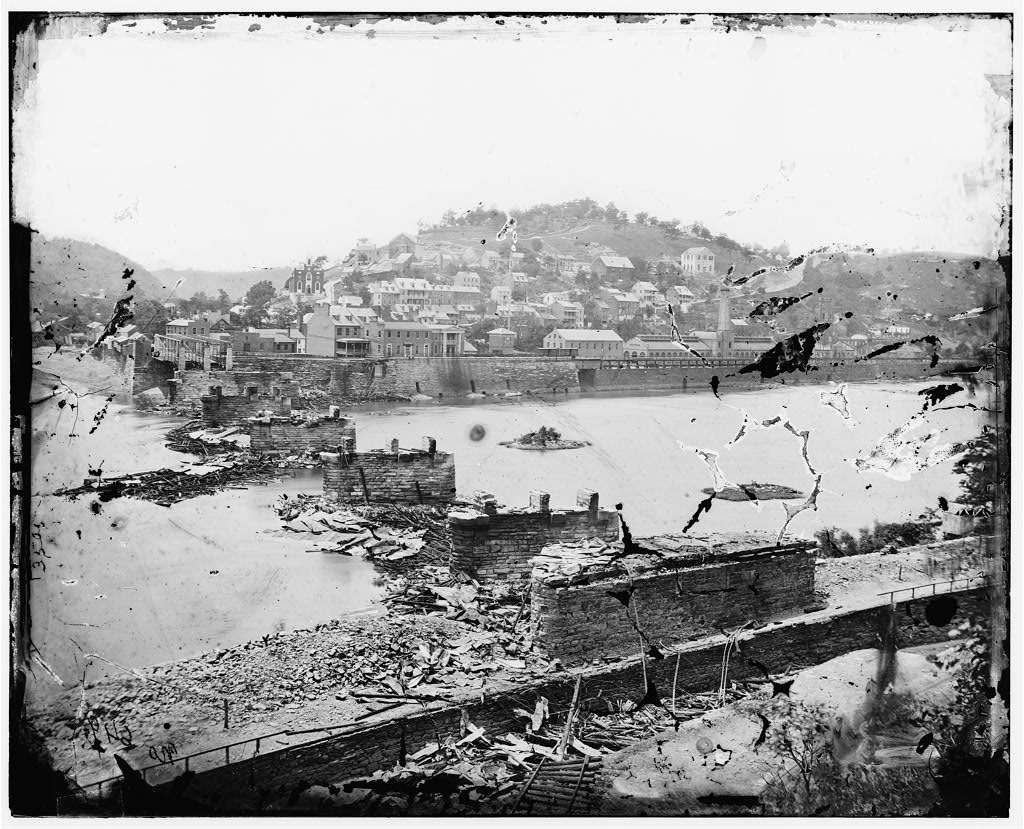
Main Page > 2009 Gettin' Gettysburg Tour Intro >
The Boy's rose very early wanting to make a full day of it. So they boogied an hour and a half southeast of Gettysburg with two steaming cups of Joe to where some say the Civil War started in the little but strategic river town of Harpers Ferry, West Virginia. With coffee's still a steamin', they boogied through the 20 miles of twisty mountainous back roads from Gettysburg.
Harpers Ferry is a historic river town in Jefferson County, West Virginia, United States where of the Potomac and Shenandoah rivers merge and where the U.S. states of Maryland, Virginia and West Virginia meet. It is the easternmost town in West Virginia. The town is located on a low-lying flood plain created by the two rivers and surrounded by higher ground. Historically, Harpers Ferry is best known for John Brown's raid on the Armory in 1859 and its role in the American Civil War. As the Boys found out the lower part of Harpers Ferry is located within Harpers Ferry National Historical Park. Most of the remainder, which includes the more highly populated area, is included in the separate Harpers Ferry Historic District. Two other National Register of Historic Places properties adjoin the town: the B & O Railroad Potomac River Crossing and St. Peter's Roman Catholic Church.
Harpers Ferry April 1863 and 2009

Harper Who? History on the Around 1750 the English colonist Robert Harper was given a patent on 125-acre at the present location of the town. In 1761 Harper established a ferry across the Potomac, making the town a starting point for European-American settlers moving into the Shenandoah Valley and further west. In 1763 the Virginia General Assembly established the town of "Shenandoah Falls at Mr. Harper's Ferry.
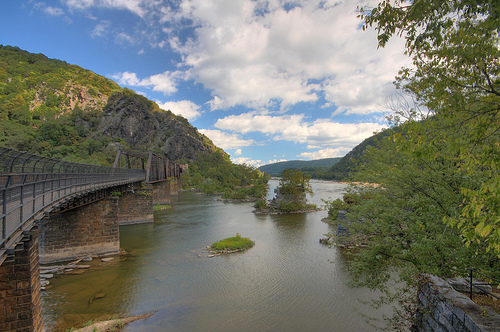
On October 25, 1783, Thomas Jefferson visited Harpers Ferry. He viewed "the passage of the Potomac through the Blue Ridge" from a rock which is now named for him. This stop took place as Jefferson was traveling to Philadelphia and passed through Harpers Ferry with his daughter Patsy. Jefferson called the site "perhaps one of the most stupendous scenes in nature." George Washington, as president of the Patowmack Company (which was formed to complete river improvements on the Potomac and its tributaries), traveled to Harpers Ferry during the summer of 1785 to determine the need for bypass canals.
The Civil War was disastrous for Harpers Ferry, which changed hands eight times between 1861 and 1865. When Virginia seceded in April 1861, the U.S. garrison attempted to burn the arsenal and destroy the machinery, to prevent the Confederates from using it. Locals saved the equipment, which the Confederate Army transferred to a more secure location in its capital of Richmond. The US Army never renewed arms production in Harpers Ferry. Because of the town's strategic location on the railroad and at the northern end of the Shenandoah Valley, both Union and Confederate troops moved through Harpers Ferry frequently. The town's garrison of 14,000 Federal troops played a key role in the Confederate invasion of Maryland in September 1862. Gen. Robert E. Lee did not want to continue on to Maryland without capturing the town. It was on his supply line and could control one of his possible routes of retreat if the invasion did not go well. Dividing his army of approximately 40,000 into four sections, Lee used the cover of the mountains to send three columns under Stonewall Jackson to surround and capture the town. The Battle of Harpers Ferry started with light fighting September 13 as the Confederates tried to capture the Maryland Heights to the northeast, while John Walker moved back over the Potomac to capture Loudoun Heights south of town. After a Confederate artillery bombardment on September 14 and 15, the Federal garrison surrendered. With 12,419 Federal troops captured, the surrender at Harpers Ferry was the largest surrender of US military personnel until the Battle of Bataan in World War II. Because of the delay in capturing Harpers Ferry and the movement of Federal forces to the west, Lee was forced to regroup at the town of Sharpsburg. Two days later he commanded troops in the Battle of Antietam, which had the highest number of deaths among troops of any single day in United States military history. By July 1864, the Union again had control of Harpers Ferry. On 4 July 1864, the Union commanding Gen. Franz Sigel withdrew his troops to Maryland Heights. From there he resisted Jubal Anderson Early's attempt to enter the town and drive the Federal garrison from Maryland Heights.
Original Site of John Browns "Fort"
In 1794 Washington's familiarity with the area led him to propose the site for a new United States armory and arsenal. Some of Washington's family moved to the area; his great-great-nephew, Colonel Lewis Washington, was held hostage during John Brown's raid in 1859, and George's brother Charles Washington founded the nearby Jefferson County town of Charles Town. In 1796 the federal government purchased a 125-acre parcel of land from the heirs of Robert Harper. In 1799 construction began on the United States Armory and Arsenal at Harpers Ferry. This was one of only two such facilities in the U.S., the other being Springfield, Massachusetts. Together they produced most of the small arms for the U.S. Army.
John Browns "Fort"
John Brown's Raid on Harper Ferry. Back in the day (1850's) the name John Brown evoked many things, ardent abolitionist, bible fanatic, or even terrorist. His initial claim to "fame" (or infamy) was in August 1855, when he followed 5 of his sons to Kansas to help make the state a haven for anti-slavery settlers. The following year, his hostility toward slave-staters exploded after they burned and pillaged the free-state community of Lawrence. Having organized a militia unit within his Osawatomie River colony, Brown led it on a mission of revenge. On the evening of 23 May 1856, he and 6 followers, including 4 of his sons, visited the homes of pro-slavery men along Pottawatomie Creek, dragged their unarmed inhabitants into the night, and hacked them to death with long-edged swords. At once, "Old Brown of Osawatomie" became a feared and hated target of slave-staters. during 2 subsequent trips to Kansas, he developed a grandiose plan to free slaves throughout the South. Provided with moral and financial support from prominent New England abolitionists,
Mike and Bone, Looking for old John Brown
Brown
began by raiding plantations in Missouri but accomplished little. In the summer
of 1859 he transferred his operations to western Virginia, collected an army of
21 men, including 5 blacks. His plan seemed fairly straightforward: he and his
men would establish a base in the
The following summer, after a one-year delay, Brown was eager to get underway.
He rented a farm in
The delay had an adverse effect on Brown's plan. Many of the men he had
recruited the previous year had changed their minds, moved away, or simply
didn't think the plan would work. Even Henry Highland Garnet, the radical
abolitionist who advocated insurrection, didn't have faith in the plan,
believing that slaves were unprepared. Brown also met with Frederick Douglass in
August of 1859, when Brown told his friend of his intentions of seizing the
federal arsenal at
On October 16, Brown set out for
After a sensational trial, he was found guilty of treason against Virginia and was hanged at Charlestown, amid much fanfare, Dec. 2, 1859. The stately, fearless, unrepentant manner in which he comported himself in court and on the gallows made him a martyr in parts of the North. The raid ultimately hastened the advent of the Civil War.
As the Boys checked out the displays in the "John Brown's Fort" they realized that this was the match that lit the Civil War.
Lookin' down on Harpers Ferry
After the Fort, Mile and Bone strolled through the very hilly village that is Harpers Ferry, after grabbing a coupla more coffees, the Boys decided to move on to Antietam, before the Day became to0 hot and humid.
Rebels without a clue at the Bloody Lane
Arriving at Antietam (the South still calls the Battle "Sharpsburg, but since we won we will call it Antietam ! Damned Rebels anyhow !]), the day was soaring into the mid 90's in both temperature and humidity,,, you could feel the pending storm in the air, just like in September 23rd 1862, the bloodiest day in the Civil War!
During the Battle Of Antietam,
The Very Bloody Lane
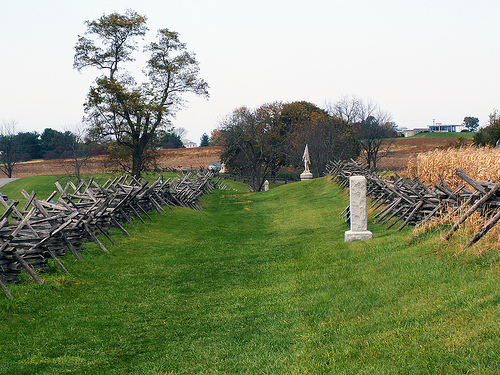
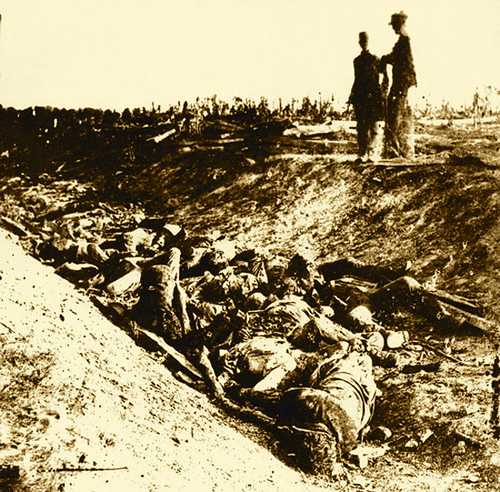
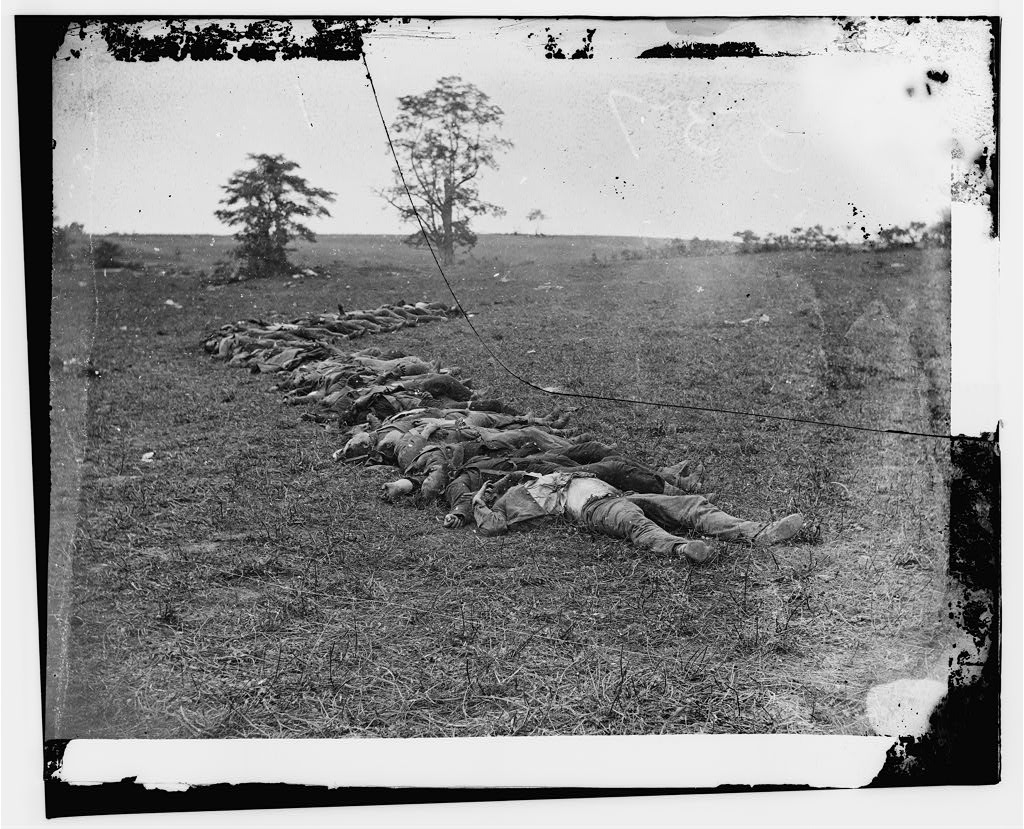
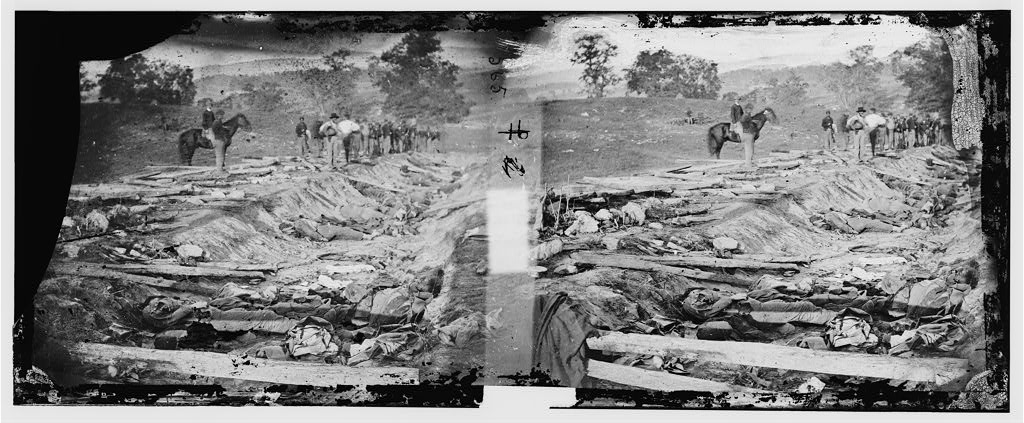
Soon, the troops which include famous Irish Brigade, clashed in a raging fight
that lasted more than three hours. The farm road was soaked with blood as the
Confederates were struck and knocked out of line, forming what seemed to be
perfect rows of dead men in the road behind them. The surviving Confederate
soldiers fled as the
Casualties, in the end, totaled to about five thousand. For nearly four hours
(about
Burnsides Bridge
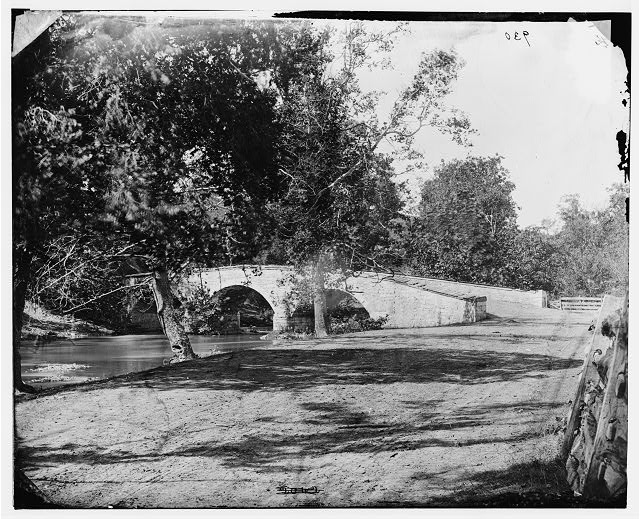
Despite the heat (and a near miss of another Civil War battle with a Ohio State Buckeye lunatic !) the Boys sat rapt as a (pictured above) National Park Ranger explained how at Burnside's Bridge the North could have won the war except for the cowardice of George McCllellan. Burnside had the Confederates on the ropes, all Burnside needed was reinforcements. McCllellan being the paranoid coward he was, refused to send anymore men into battle, and tipped the scales to Lee, which brought in Hill's division which help drive off Burnside thus ending the Battle for the day in a draw.
Again, the bloodiest day in American History.
Lincoln and McClellan at Antietam
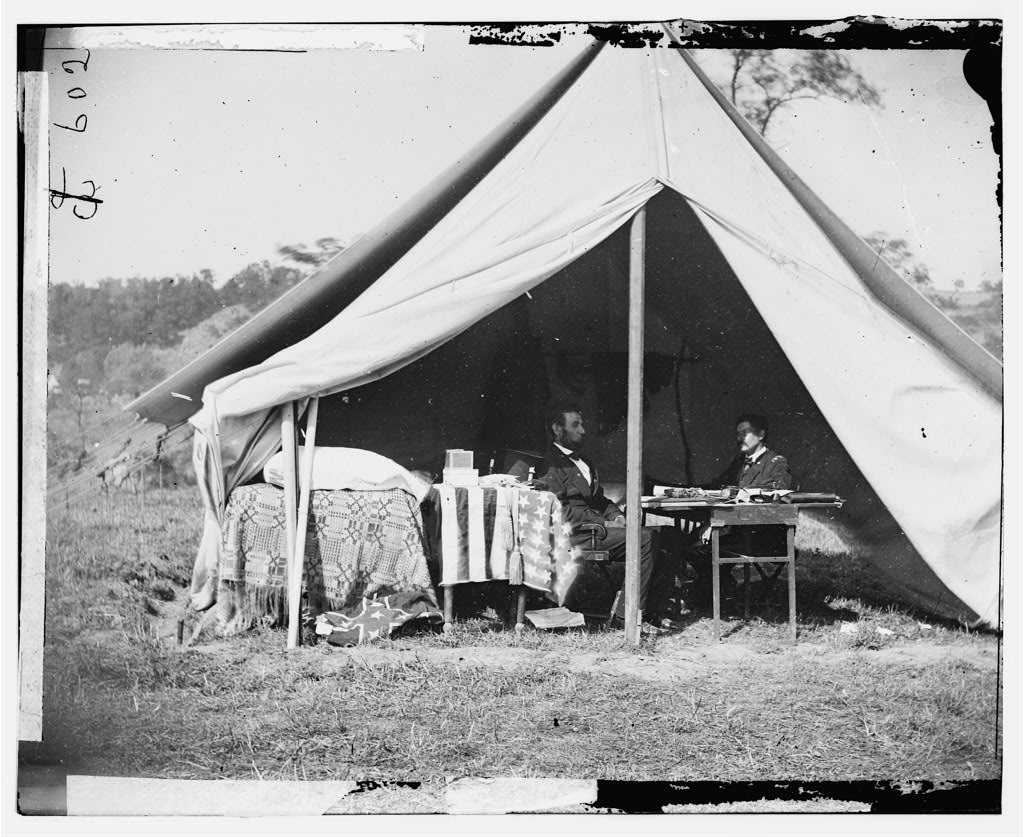
The next day McClellan had no further stomach for fighting and let Lee and the Army of Northern Virginia march away, which prompted Lincoln to meet with McClellan for this picture, then smartly removed the loser from command.
With the end of the Rangers discussion, it was hitting high noon and the Boys were very thirsty ! So with beverages in mind and on the mind, they headed back, but first stopped to pick up a 12 frosty-cold Bass Ale's for the Hall of Shame, and then found a bucolic route back to Gettysburg!
Everlost's "Least use of Freeways" Route !
The Notorious Return of the "Hall of Shame !"
While the Eastern forest was luminously green, the sky darkening quite ominously, regardless of the weather, the Boys were oblivious since the beers were going down like water ! Which made for a very enjoyable ride back where they did a quick tour of the brand, spanking new Gettysburg Battlefield National Museum,
Gettysburg Bikers Weekend: destroyed by Rain and Mike & Bone!
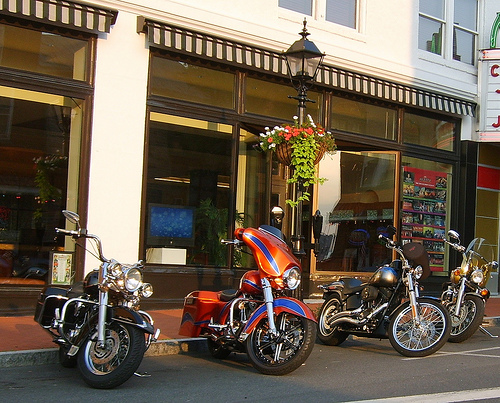
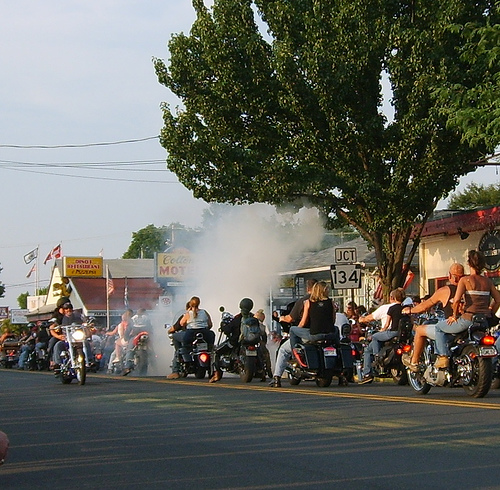
By sheer luck, the Boys choose the Gettysburg Bikers Weekend to tour, unfortunately neither the Weather nor Mike and Bone would make it a good weekend for the bikers !!
C'mon only one drink and a quick lunch, Do'hhh
After Harpers Ferry, Antietam the Gettysburg Museum, and a few rounds from the Hall of Shame, the Boys were well ready for lunch and a few more beers. Walking into J's, a lovely outdoor restaurant that Sarah had recommended, the Boys noticed a table with a fruit and cheese tray, which looked awful good for lunch on such a hot and steamy day. So the they ordered a the fruit & cheese tray, a couple of micro-brews, and two shots of the wicked and loathsome Irish Whisky known as Bushmills !! Which unfortunately would change the course of the day!
Toothless Mike !, with a wicked American IPA !
Gangsta Bone, hammered and soaked (plus wet from the Rain!)
"Let it Rain!" - Eric Clapton
Mike and Bone getting soaked and, ,, well soaked in Bushmill's
The problem with Bushmills is that you start with the idea of only having two shots, and soon have the whole damned bottle ! As the boys order continued rounds of beers and shots, the heat and humidity finally built to such a an unbearable crescendo, that around 2:30 and the skies opened up with lots of lightening, thunder, and tremendous amounts of rain. As the bikers, the sane and sober left the streets, Mike and Bone continued to sit on the Patio until 7:00 PM drinking shots and beers, They left only because J's Bar's bottle of Bushmills actually gave out !
The Dominos fell that evening!
Now with an completely inappropriate amount of booze in them, neither Mike nor Bone were in any state to see Mike's Grandkids, so Mike called Sarah to somewhat gracefully and mostly incoherent, declined the dinner offer.
The drive to the Hotel was doubly interesting and epic since Mike did not feel he needed to stay in the car while it was moving, and let all passers-by hear his displeasure. Upon getting the Hotel Room, the Boys ordered a Dominos pie for a very much needed dinner, Unfortunately neither of them had any Pizza since they both passed out for the night thus ending and epic and ugly episode !!!